1997 PONTIAC GRAND AM run flat
[x] Cancel search: run flatPage 2 of 371
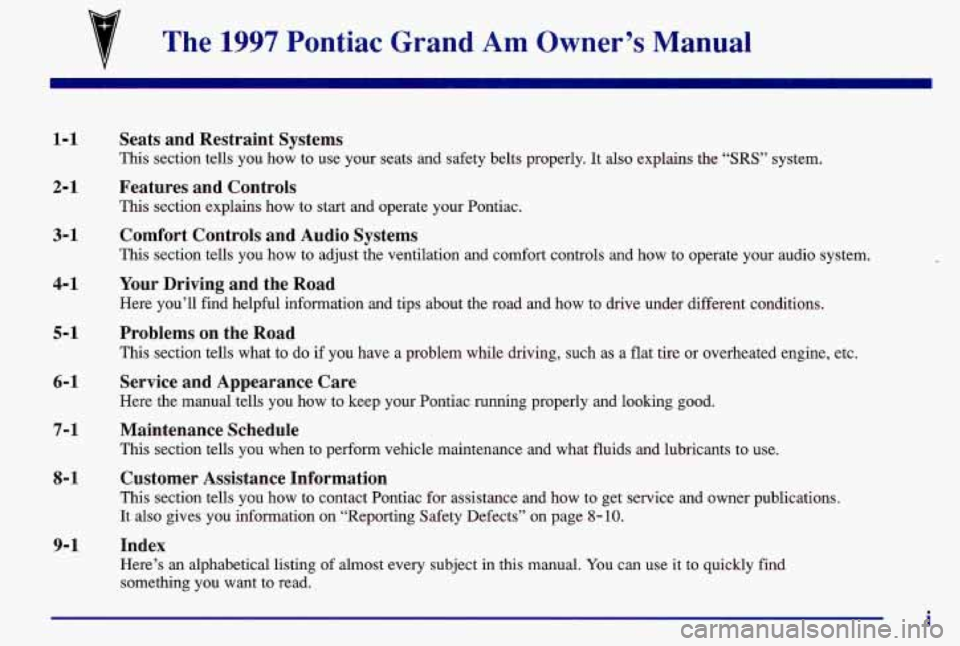
7 The 1997 Pontiac Grand Am Owner’s Manual
1-1
2- 1
3-1
4- 1
5-1 6-1
7-1
8-1
9- 1
Seats and Restraint Systems
This section tells you how to use your seats and safety belts properly. It also explains the “SRS” system.
Features and Controls
This section explains how to start and operate your Pontiac.
Comfort Controls and Audio Systems
This section tells you how to adjust the ventilation and comfort controls and how to operate your audio system.
Your Driving and the Road
Here you’ll find helpful information and tips about the road and how to drive under different conditions.
Problems on the Road
This section tells what to do if you have a problem while driving, such as a flat tire or overheated engine, etc.
Service and Appearance Care
Here the manual tells you how to keep your Pontiac running properly and looking good.
Maintenance Schedule
This section tells you when to perform vehicle maintenance and what fluids and lubricants to use.
Customer Assistance Information
This section tells you how to contact Pontiac for assistance and how to get service and owner publications.
It also gives you information on “Reporting Safety Defects” on page
8- 10.
Index
Here’s an alphabetical listing of almost every subject in this manual. You can use it to quickly find
something you want to read.
i
Page 50 of 371
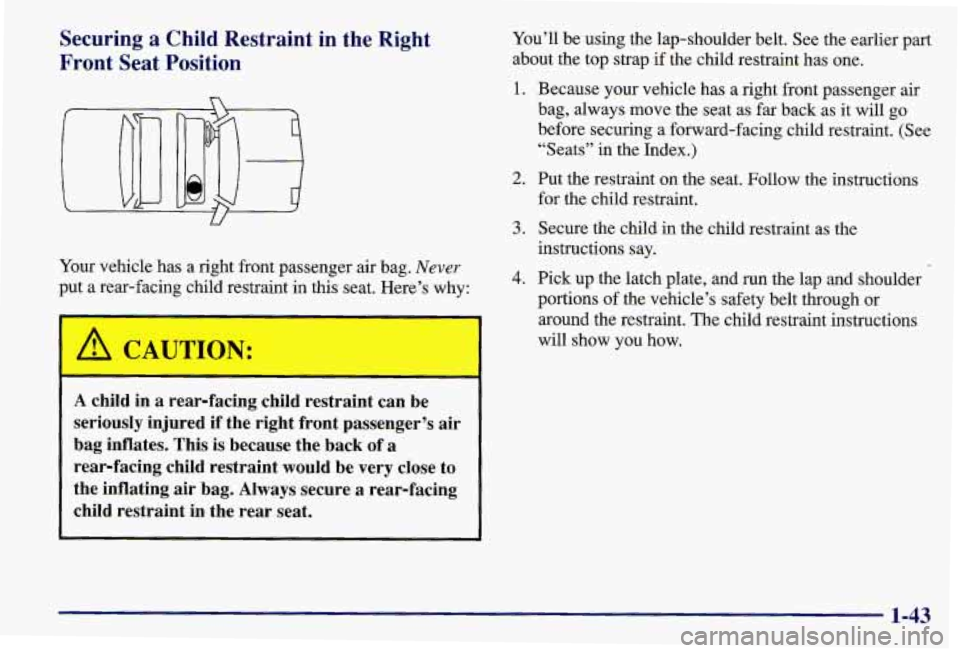
Securing a Child Restraint in the Right
Front Seat Position
Your vehicle has a right front passenger air bag. Never
put a rear-facing child restraint in this seat. Here’s why:
A CAUTION:
A child in a rear-facing child restraint can be
seriously injured if the right front passenger’s air
bag inflates. This is because the back of a
rear-facing child restraint would be very close to
the inflating air bag. Always secure a rear-facing
child restraint in the rear seat.
You’ll be using the lap-shoulder belt. See the earlier part
about the top strap
if the child restraint has one.
1. Because your vehicle has a right front passenger air
bag, always move the seat as
far back as it will go
before securing a forward-facing child restraint. (See
“Seats” in the Index.)
2. Put the restraint on the seat. Follow the instructions
for the child restraint.
3. Secure the child in the child restraint as the
instructions say.
4. Pick up the latch plate, and run the lap and shoulder
portions
of the vehicle’s safety belt through or
around the restraint.
The child restraint instructions
will show you how.
1-43
Page 106 of 371
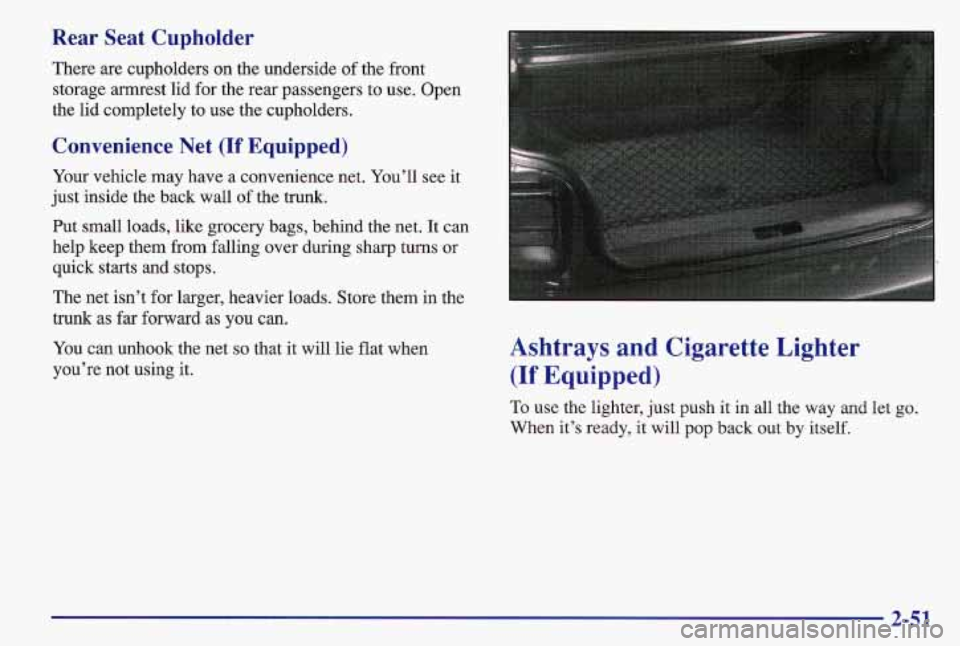
Rear Seat Cupholder
There are cupholders on the underside of the front
storage armrest lid
for the rear passengers to use. Open
the lid completely to use the cupholders.
Convenience Net (If Equipped)
Your vehicle may have a convenience net. You’ll see it
just inside the back wall
of the trunk.
Put small loads, like grocery bags, behind the net. It can
help keep them from falling over during sharp turns
or
quick starts and stops.
The net isn’t for larger, heavier loads. Store them
in the
trunk as far forward as you can.
You can unhook the net
so that it will lie flat when
you’re not using it. Ashtrays and Cigarette Lighter
(If Equipped)
To use the lighter, just push it in all the way and let go.
When it’s ready, it will pop back
out by itself.
2-51
Page 184 of 371
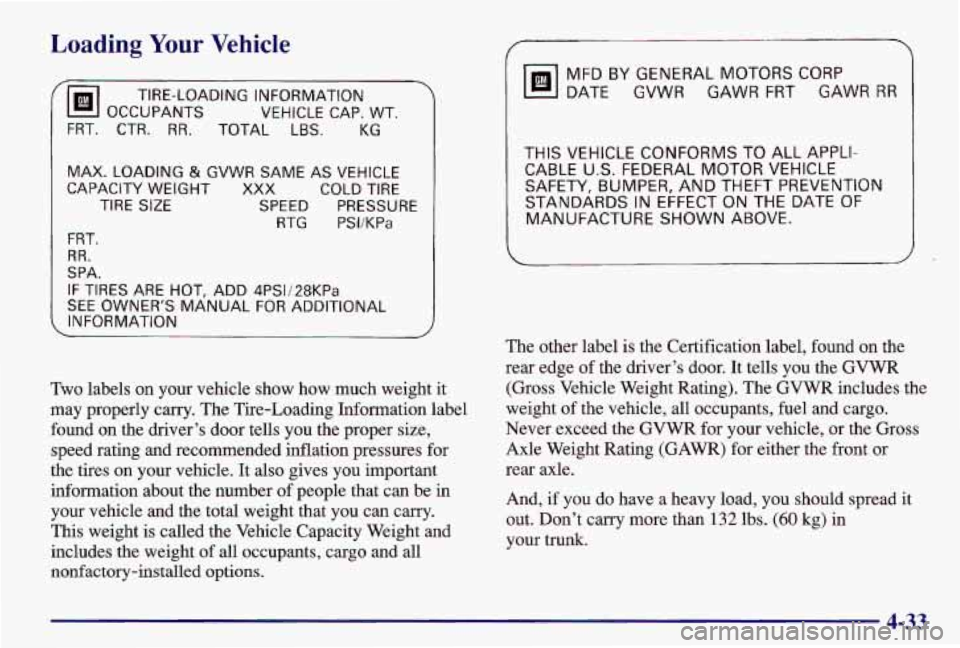
Loading Your Vehicle
TIRE-LOADING INFORMATION VEHICLE CAP. WT.
FRT, CTR.
RR. TOTAL LBS.
MAX. LOADING & GVWR SAME AS VEHICLE
CAPACITY WEIGHT
XXX COLD TIRE
TIRE SIZE SPEED PRESSURE
RTG PSliKPa
FRT.
RR.
SPA. IF TIRES ARE
HOT, ADD 4PS1/28KPa
SEE OWNER‘S MANUAL FOR ADDITIONAL
INFORMATION
Two labels on your vehicle show how much weight it
may properly carry. The Tire-Loading Information label
found on the driver’s door tells you the proper size,
speed rating and recommended inflation pressures for
the tires on your vehicle. It also gives you important
information about the number
of people that can be in
your vehicle and the total weight that you can carry.
This weight is called the Vehicle Capacity Weight and
includes the weight of all occupants, cargo and all
nonfactory-installed options.
f
MFD BY GENERAL MOTORS CORP
DATE GVWR
GAWR FRT GAWR RR
THIS VEHICLE CONFORMS TO ALL APPLI-
CABLE U.S. FEDERAL MOTOR VEHICLE
SAFETY, BUMPER, AND THEFT PREVENTION
STANDARDS
IN EFFECT ON THE DATE OF
MANUFACTURE SHOWN ABOVE.
The other label is the Certification label, found on the
rear edge of the driver’s door. It tells
you the GVWR
(Gross Vehicle Weight Rating). The GVWR includes the
weight of the vehicle, all occupants, fuel and cargo.
Never exceed the GVWR for your vehicle,
or the Gross
Axle Weight Rating (GAWR) for either the front or
rear axle.
And,
if you do have a heavy load, you should spread it
out. Don’t carry more than
132 lbs. (60 kg) in
your
trunk.
4-33
Page 223 of 371
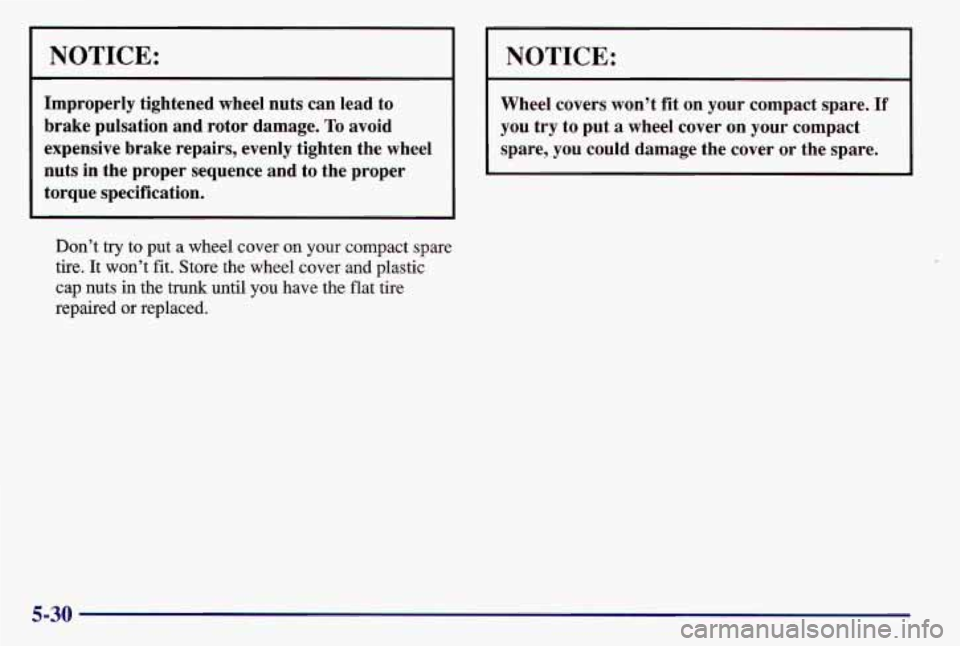
NOTICE:
Improperly tightened wheel nuts can lead to
brake pulsation and rotor damage.
To avoid
expensive brake repairs, evenly tighten the wheel
nuts in the proper sequence and to the proper
torque specification.
Don’t try to put a wheel cover on your compact
spare
tire. It won’t fit. Store the wheel cover and plastic
cap nuts in the
trunk until you have the flat tire
repaired
or replaced.
NOTICE:
Wheel covers won’t fit on your compact spare. If
you try to put a wheel cover on your compact
spare, you could damage the cover or the spare.
5-30
Page 266 of 371
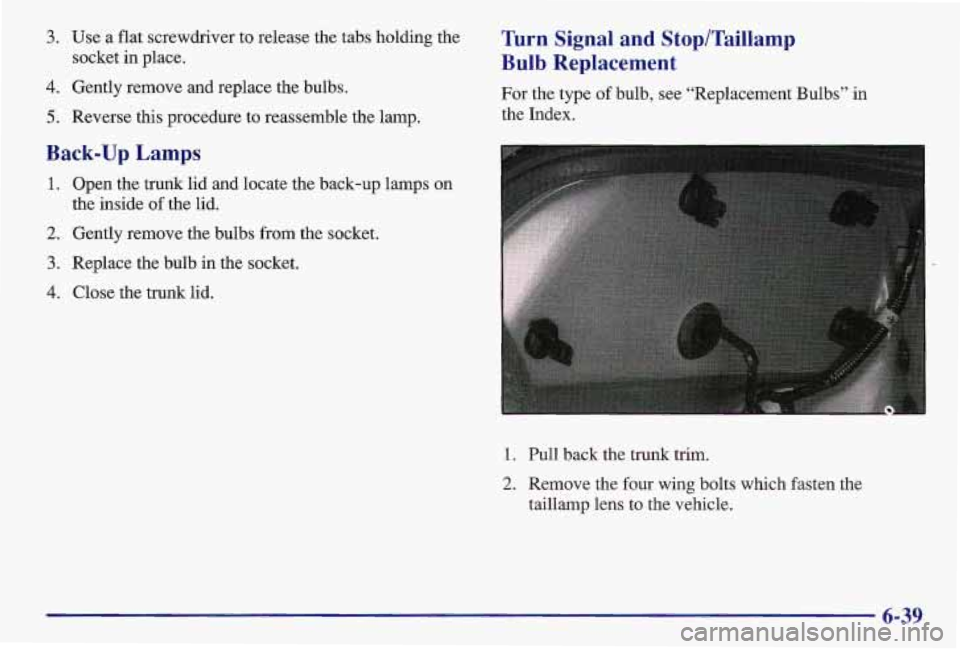
3. Use a flat screwdriver to release the tabs holding the
socket in place.
4. Gently remove and replace the bulbs.
5. Reverse this procedure to reassemble the lamp.
Turn Signal and Stop/Taillamp
Bulb Replacement
For the type of bulb, see “Replacement Bulbs” in
the Index.
Back-up Lamps
1. Open the trunk lid and locate the back-up lamps or1
2. Gently remove the bulbs from the socket.
3. Replace the bulb in the socket.
4. Close the trunk lid.
the
inside of the lid.
1. Pull back the trunk trim.
2. Remove the four wing bolts which fasten the
taillamp lens to the vehicle,
6-39
Page 362 of 371
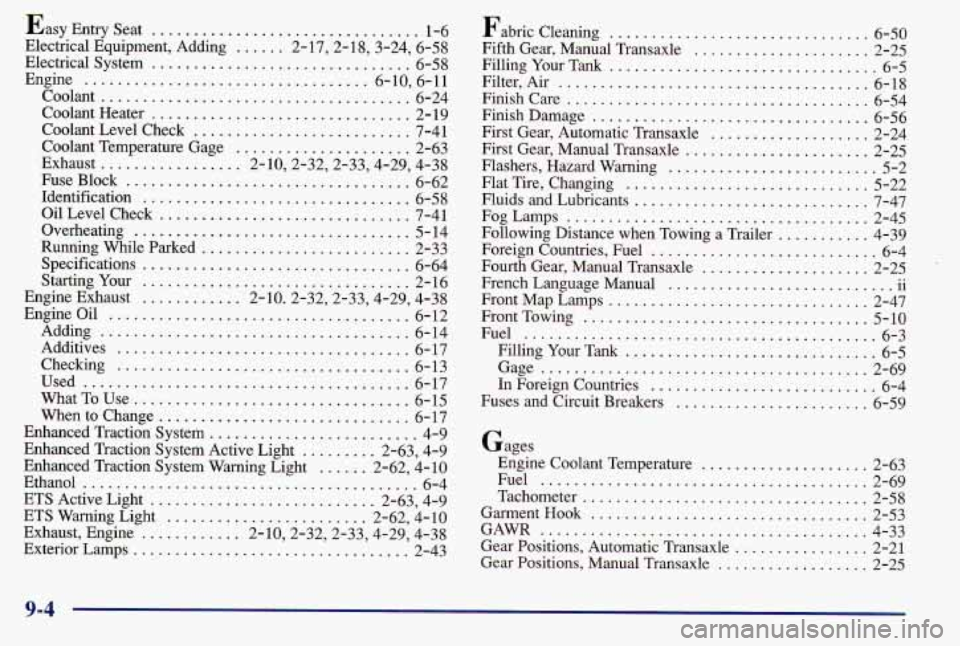
Easy Entry Seat ................................ 1-6
Electrical Equipment. Adding
...... 2.17. 2. 18. 3.24. 6-58
Electrical System
............................... 6-58
Engine
.................................. 6.10. 6.11
Coolant
..................................... 6-24
Coolant Heater
............................... 2- 19
Coolant Level Check
.......................... 7-41
Coolant Temperature Gage
..................... 2-63
Exhaust
................. 2-10.2-32,2-33.4-29. 4-38
Fuse Block
.................................. 6-62
Identification
................................ 6-58
OilLevelCheck
.............................. 7-41
Overheating
................................. 5 - 14
Running While Parked
......................... 2-33
Specifications
................................ 6-64
StartingYour
................................ 2-16
Engine Exhaust
............ 2-10.2-32,2-33,4-29,4-38 Engine Oil .................................... 6-12
Adding
..................................... 6-14
Additives
................................... 6- 17
Used
....................................... 6-17
What To Use
................................. 6-15
Enhanced Traction System
......................... 4-9
Enhanced Traction System Active Light
......... 2-63. 4-9
Enhanced Traction System Warning Light
...... 2-62. 4-10
Ethanol
........................................ 6-4
ETS Active Light
........................... 2-63, 4-9
ETS Warning Light
........................ 2-62. 4- 10
Exhaust, Engine
............ 2-10.2-32.2-33.4-29. 4-38
Exterior Lamps
................................. 2-43
Checking
................................... 6-13
Whentochange
.............................. 6-17 Fabric
Cleaning
............................... 6-50
Fifth Gear. Manual Transaxle
..................... 2-25
Filling Your Tank
................................ 6-5
Filter. Air
..................................... 6-18
Finish Care
.................................... 6-54
Finish Damage
................................. 6-56
First Gear, Automatic Transaxle
................... 2-24
First Gear, Manual Transaxle
...................... 2-25
Flashers, Hazard Warning
......................... 5-2
Flat Tire, Changing
............................. 5-22
Fluids and Lubricants
............................ 7-47
Following Distance when Towing a Trailer
........... 4-39
Foreign Countries, Fuel
........................... 6-4
Fourth Gear, Manual Transaxle
.................... 2-25
French Language Manual
........................... 11 *.
Front Map Lamps ............................... 2-47
Front Towing
.................................. 5-10
Fuel
........................................ 6-3
Gage
....................................... 2-69
In Foreign Countries
........................... 6-4
Fuses and Circuit Breakers
....................... 6-59
FogLamps
.................................... 2-45
Filling Your Tank
.... ...................... 6-5
Gages Engine Coolant Temperature
.................... 2-63
Fuel
....................................... 2-69
Tachometer
.................................. 2-58
GarmentHook
................................. 2-53
GAWR
....................................... 4-33
Gear Positions, Automatic Transaxle
................ 2-21
Gear Positions, Manual Transaxle
.................. 2-25
9-4